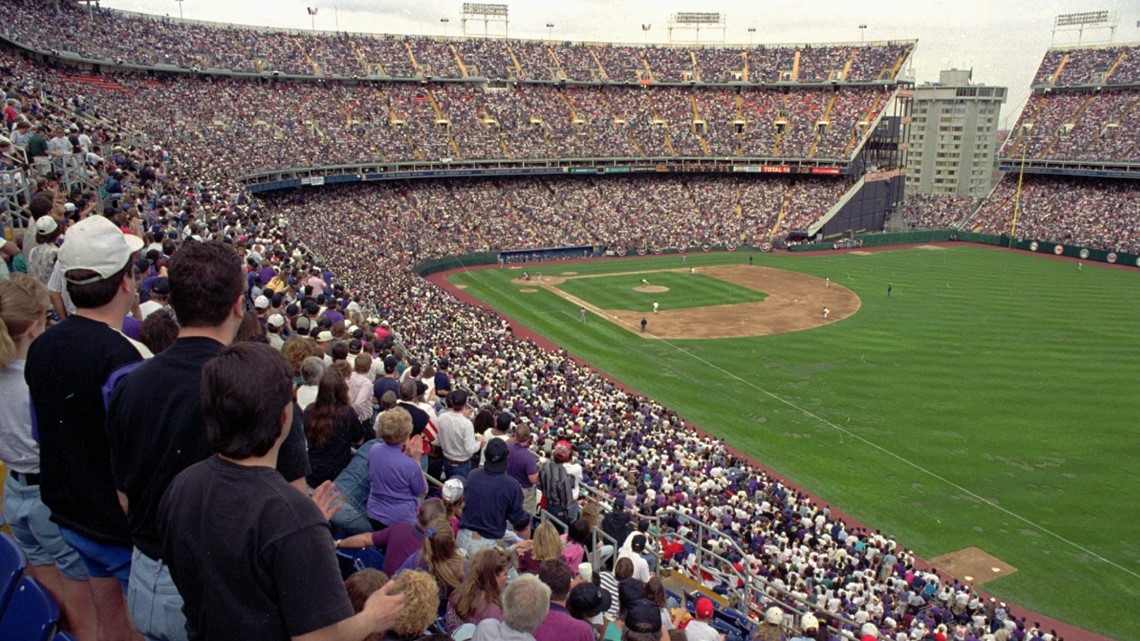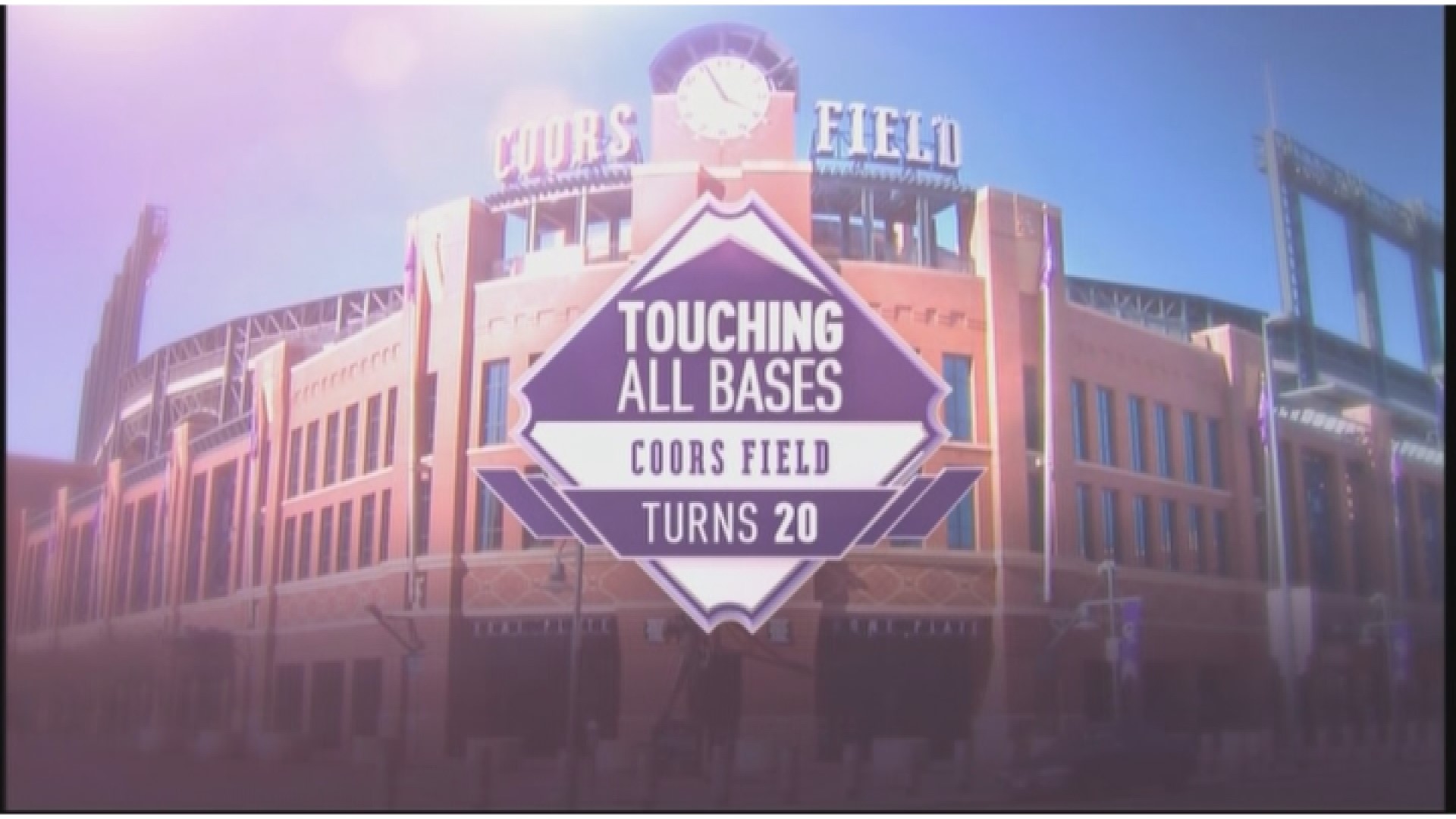DENVER — Like most heroes from a time later recalled for posterity, Eric Young in the moment didn’t understand what he had done.
Oh, he could feel he had done something special.
A record crowd of 80,227 fans who were jammed inside a 74,000-seat football venue roared so loudly 30 years ago, the aging Mile High Stadium’s beams shook from its bolted joints when EY led off the home team’s first-ever Major League Baseball game in the city of Denver with a home run.
Rockies 1, Expos 0. Times a gazillion.
“The funny part, I didn’t realize the magnitude of that home run and what it meant,’’ Young said in a phone interview with 9NEWS as the Rockies celebrated their 25th anniversary.
“To jump-start our offense, that’s what I was thinking about. But people in that region, it was bigger than Colorado and Denver right there. I didn’t realize that when it happened.”
I was there in a cramped, righties bumping lefties makeshift baseball press box that bounced. Shook and swayed from all the foot stomping and jumping and cheers and screams and whistles and claps -- did we mention there were 80,227 people there? -- as Young’s fly ball to left carried beyond the fence.
The press box so shook and swayed, I feared for a second us scribes were going down. Top heavy over, face-first fall into the stands below.
Luckily, the rickety attachments held.


“It’s no lie, I know you felt that because I felt like I was floating running around the bases,’’ Young told 9News this week as he was asked to recall one of the most magical moments in Colorado sports history. “That was a feeling that in my career I never experienced.
“The whole stadium was shaking. It was unbelievable. Really, I felt like I was running on air. … I didn’t feel touching first base, second, third base and home plate. It was unbelievable. My body got numb.’’
There was that moment in time. And there was that singular moment that stayed with Young through the next 27 years. Built like a small halfback, Young would have 13 more seasons as a player and finish with a rare major-league career that compiled more stolen bases (465) than strikeouts (462). He also scored 996 runs and hit .409 with 2 homers in 7 postseason games.
Providing the coronavirus pandemic does reach a life-resuming resolution, he will continue on with his eighth season as a big-league coach, second with the Atlanta Braves.
Nothing tops what he did to the 3-and-2 Kent Bottenfield fastball as the first batter in Colorado Major League Baseball home history.
“When I think about other things I’ve achieved in the game -- when I stole the 6 bags (in a 1996 game against the Dodgers), batting good in the playoffs, other big hits in my career, that one right there was the signature one for many people,’’ Young said. “My individual stuff was for me and that’s why this means more to me is because it affected so many other people. So many other people have cherished it, remembered it and held close to that moment.’’
Resourceful seating led to 80,227 record
The problem with trying to break MLB’s old opening day record crowd of 78,672 – set way back in 1958 when the Dodgers played their first game in Los Angeles after moving from Brooklyn -- wasn't getting enough people to buy tickets.
It was finding the seats. Mile High Stadium, home in some shape and name to the NFL Broncos since 1960, had roughly a 74,000-seat capacity for baseball. John McHale Jr., the Rockies’ first executive vice president of baseball operations, arranged to have temporary bleacher seats placed in center field and down the left- and right-field lines. One time only. Just for the Rockies’ first home game on April 9, 1993 against the Montreal Expos.
“I remember he called me one day and said, ‘Bill can I put some seats in center field, we want to break the (attendance) record,’’’ former National League president Bill White said in a 2015 interview with 9News. “I said all right, but when I got there, I saw where those seats were. They were right in the batter’s vision. I said, “You tricked me.”’
Then there were an additional 350-400 chairs that were placed behind the stadium's beams.
"I'm not going to lie, those are obstructed-view seats," stadium manager Gary Jones told the Colorado Springs Gazette Telegraph on that April 9, 1993 morning. "But that's what the team wanted to break that record."
It’s safe to assume that crowd of 80,277 will never be broken on opening day or in a National League park again. For two reasons. One, only Dodger Stadium (56,000), which opened in 1962 and Coors Field (50,445), which opened in 1995, have capacities greater than 49,300 among MLB ballparks.
And two, it would likely be illegal to do so. Privately, Rockies officials figured their temporary seating setup had broken several of the city’s fire code laws.
“Of course I don’t have an exact count – but it felt like there were 50,000 there for BP,’’ Young said. “That area was rocking. I think I came to the ballpark at 9 o’clock and it was packed already in the parking lot.’’
Rockies players were stunned by their support. They had all been on other major league teams and in the minors the year before. They were then chosen in the National League expansion draft in November 1992 by Rockies general manager Bob Gebhard.
The first time the new Rockies players gathered was in Tucson, Ariz. for six weeks of spring training.
Through the daily horde of Denver media that had descended upon the desert, the players got an idea of how manic their new city was for baseball. But there is nothing quite like seeing to believe.
“I remember “Groove,” may he rest in peace, he always said in spring training, ‘You guys have no idea what you’re about to walk into,’’’ Young said of his manager, Don “Groove” Baylor. “This is big.’ I was like, ‘Yeah, Opening Day, you know.’’
The Rockies lost the first two games in franchise history to the Mets, by scores of 3-0 and 6-1, but those games were played at New York’s Shea Stadium. Rockies hitters were no match for Dwight “Doc’’ Gooden and Bret Saberhagen.
The games mattered officially in the standings, but not to the baseball-starved fans in the Rocky Mountain Region.
What mattered to them was Denver would be the home team in a Major League Baseball game for the first time at 3:05 p.m. Friday, April 9. As the stands filled a couple hours before game time, EY had a pregame catch with his 7-year-old son, Eric Young Jr. His mom and dad were there.
At 2:45 p.m. folk-pop singer Dan Fogelberg of Durango sang the National Anthem. Rockies’ veteran pitcher Bryn Smith allowed two, two-out hits in the first, but got out of the inning.
And then EY stepped up as the Rockies’ leadoff batter in the bottom of the first. The first count went full. Young didn’t swing at the two strikes. Bottenfield, a curious choice as Montreal’s starting pitcher in such a pressure-packed environment as a 24-year-old rookie, didn’t want to walk the first batter.
“High fastball, 3-2, about waist high,’’ Young said. “Because I was crouched over.’’
To those watching baseball playing at 5,280 feet above sea level for the first time, Young’s first swing seemed to connect for a fly ball to left. But then the ball carried and Expos left fielder John Vander Wal – who would later become an extraordinary pinch-hitter and backup outfielder for the Rockies – started leaning into the left field wall, roughly 380-foot away.
“I hit it 381 then,’’ Young said.
It was suggested that altitude helped carry the fly ball to bedlam.
“Oh yeah, absolutely,’’ Young said. “I would not discount that. I truly felt hearing that crowd roar when I hit it -- because everybody pretty much jumped to their feet -- and then that loud roar just pushed that ball because I thought (Vander Wal) was going to catch it on the warning track.
“The way he was going after that ball, and then I said, “Oh my god he’s still running. He’s still running.’ I think when I got halfway to second base I realized, “It’s gone. I got a home run!”’
After floating around the bases, the crowd beckoned for a curtain call. Young obliged, stepping out of the dugout, doffing his helmet and giving the crowd a first pump.
Later in the inning, Charlie Hayes hit a two-run homer to give the Rockies a 4-0 lead. Who was the second man on the moon again?
“Yeah, exactly,’’ Young said laughing. “I don’t know. See.”
Smith was pulled after the 7th with the Rockies up, 11-0. It got a little ugly in the final two innings but Colorado would finish off its first major-league win, 11-4.
No. 1 sports moment in Denver history?
There was the height of Broncomania, in 1977 when the Broncos beat the Raiders in the AFC Championship Game at Mile High to earn Denver’s first trip to the Super Bowl.
There was the Avalanche clinching the Stanley Cup with a 1-0, triple-overtime Game 4 at the McNichols Sports Arena in 1996.
There was Champ Bailey’s 100-yard interception return against Tom Brady at the stadium the Broncos use now.
There was the incredible Rocktober of 2007 and Tebow to Demaryius in the 2011 AFC playoff upset of the Steelers.
Maybe because there have been more bad days than good for a Rockies’ franchise that has still never won an NL West Division title through its 27 seasons, it’s not easy to remember the baseball hysteria in the early years.
The Rockies not only played before 80,227 in their first home game, they played before at least 70,000 in 21 home games through their first two seasons of 1993-94. There were 109 home games when the Rockies played before at least 50,000 fans in 1993-94.
Then came a sellout streak that lasted four years at new Coors Field.
To those who paid witness during that time, EY’s homer – and that’s simply what it’s long been called, “EY’s homer” – may well be the No. 1 moment in Denver sports history.
Throughout his career – as a player and a coach – people would approach him.
“I was there,’’ Young said in describing what people tell him. “I remember when I was there, the famous line.”
His son, EY Jr., later started his 10-year big-league career with the Rockies, even leading the National League with 46 stolen bases in 2013.
He may have been the first Young Sr. helped guide to the big leagues, but he’s hardly been the last. A coach for the Diamondbacks, Rockies under manager Walt Weiss, and now the Braves, Young would like to manage one day.
A natural leader and motivator whose mind clears when the pressure mounts, Young would be a good one.
Maybe by the 30th-year history of his famous leadoff homer – who knows? -- he can answer questions about it from the top step of the Rockies’ dugout.
Until then, at least 80,277 people have approached him, starting with the rest of that inaugural 1993 season and now as Major League Baseball attempts to move into another decade, who have told him they were there.
“You know what, add some,’’ Young said. “There were more who were not there who were watching it on TV. They felt like it they were there.
“This is going to be an ongoing story till the day I die. And then some.”

